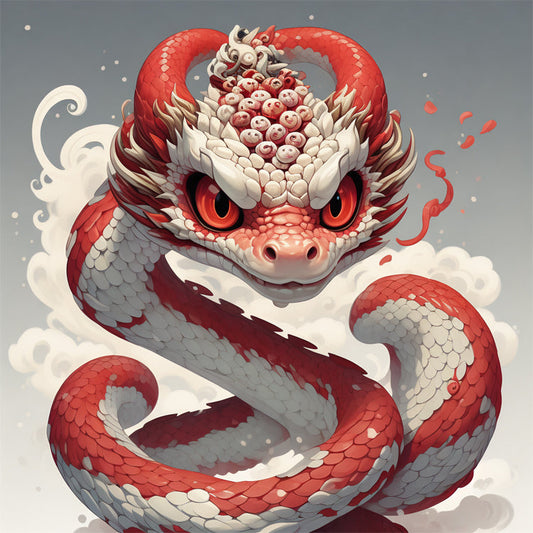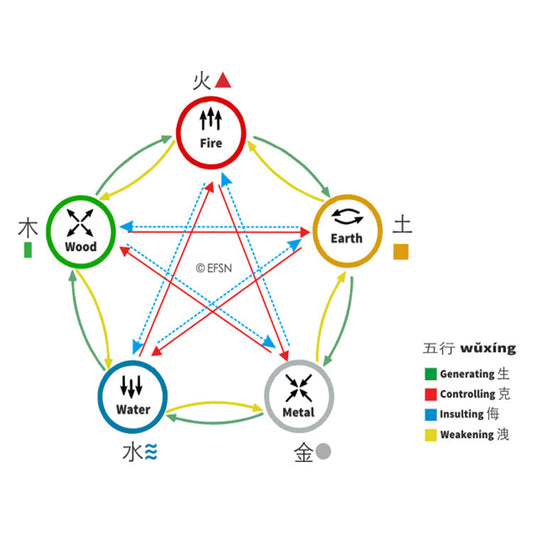Fortune Telling Based On the Five Elements and Eight Characters of Birth Date
Eight Characters
①. Eight-character elements
- Yin and Yang
Regarding "yin and yang", "Yi Zhuan" proposed an explanation: "One yin and one yang is called Tao." Everything in the universe is composed of two forces called yin and yang.
Yin and Yang are divided into "odd yang and even yin". Those born in the five yang years (odd years) of Jia, Bing, Wu, Geng, and Ren are called "yang men" for men and "yang women" for women. On the contrary, those born in the years of Yi, Ding, Ji, Xin, and Gui (even years) are called "yin men" for men and "yin women" for women. - Five Elements
In Han culture, the ancients regarded wood, fire, earth, gold, and water as the five basic substances that constitute the universe. Each of the five elements contains life and death. The theory of eight-character fate advocates that "the one who lives has feelings, and the one who is restrained has righteousness". The balance between life and death is sought. Any excessive or insufficient life, excessive or insufficient restraint, etc., will bring negative effects. - Heavenly Stems and Earthly Branches
The Heavenly Stems and Earthly Branches, also known as Heavenly Stems and Earthly Branches, are said to have been created by the Yellow Emperor. In addition to being used to calculate time or date, they are also considered to be the epitome of the universe. However, the two have different properties. The Heavenly Stems are active and the Earthly Branches are static. Since the Heavenly Stems have their own active mobility, their actual influence is greater than that of the static Earthly Branches. The interaction between the Heavenly Stems and Earthly Branches, such as "generation, restraint, transformation, combination, punishment and conflict", is the basic principle of fortune-telling in Bazi numerology. - Eight-character numerology
The eight-character numerology is based on a person's birth time, including the hour, day, month, and year. It can be converted into the arrangement and combination of heavenly stems and earthly branches according to the perpetual calendar. It can be divided into the hour column of "hour stem and hour branch", the day column of "day stem and day branch", the month column of "month stem and month branch", and the year column of "year stem and year branch", totaling "four pillars and eight characters". This method was created by Xu Ziping and is also known as "Ziping School" or "Four Pillars and Eight Characters School".
Eight-character numerology analysis
The core of the eight-character numerology analysis includes the following aspects:
- Four pillars:
The "four pillars" in the eight characters refer to the year pillar, month pillar, day pillar, and hour pillar. Each pillar consists of a heavenly stem and an earthly branch, a total of eight characters, so it is called "eight characters". The order of the four pillars is: the year pillar is the heavenly stems and earthly branches of the birth year, the month pillar is the month pillar, the day pillar is the heavenly stems and earthly branches of the birth date, and the hour pillar is the heavenly stems and earthly branches of the birth time. - Heavenly stems and earthly branches:
Heavenly stems and earthly branches are the system used to record time in ancient China. There are ten heavenly stems: Jia, Yi, Bing, Ding, Wu, Ji, Geng, Xin, Ren, Gui; there are twelve earthly branches: Zi, Chou, Yin, Mao, Chen, Si, Wu, Wei, Shen, You, Xu, Hai. The heavenly stems and earthly branches in each pillar are combined to form each character in the eight characters. - Yin and Yang Five Elements:
The heavenly stems and earthly branches in the eight characters correspond to the five elements (gold, wood, water, fire, and earth) and have yin and yang properties. The relationship between the five elements and the balance of yin and yang are important bases for analyzing the fate. - Ten Gods:
The ten gods are another set of symbol systems in the eight characters, which are used to represent the relationship between the life master (i.e. the day master) and other heavenly stems and earthly branches. The ten gods include Zhengyin, Pianyin, Zhengguan, Qisha, Zhengcai, Piancai, Shishen, Shangguan, Bijian and Jiecai. Each of the ten gods has its own specific symbolic meaning, which is used to analyze the personality, career, marriage and other aspects of the person. - Fate analysis:
The process of fortune-telling with eight characters includes arranging the plate, analyzing the fate, and calculating the great luck and the fleeting year. Arranging the plate is to generate a eight-character plate based on the time of birth. Analyzing the fate is to infer the personality and destiny of the person based on the heavenly stems and earthly branches, the balance of the five elements, and the relationship between the ten gods in the eight characters. The great luck and the fleeting year predict the changes in the fortune of the person in different time periods through the "great luck" of a decade and the "fleeing year" of each year. - Evil spirits:
Evil spirits are some special symbols in the eight characters, which are used to supplement the interpretation of the eight-character fate. They usually indicate special fate characteristics, such as peach blossoms (related to love), general stars (related to power), etc.
The analysis of the eight-character plate attempts to reveal the trends and possible events in a person's destiny through complex calculations and analysis. Although it has a long history in traditional Chinese culture, it is a prediction method without scientific basis from the perspective of modern science.
3. Five Elements Likes and Uses
The Five Elements Likes and Uses refer to the five elements that play the best role in supplementing the day master (i.e. the heavenly stem of the birth date) in the eight-character fate. The method of querying the five elements likes and uses usually includes the following steps:
- Determine the heavenly stem of the birth date: that is, the day master.
- Analyze the eight-character fate: According to the combination of the four pillars and eight characters, analyze the relationship between the five elements, as well as the strength and needs of the day master.
- Determine the likes and uses: According to the five elements of the day master and the balance of the five elements in the fate, determine the five elements that are most beneficial to the day master as the likes and uses.
A brief description of the likes and dislikes of the five elements:
- Metal: Likes earth to generate gold, water to leak gold gas, dislikes fire to overcome gold, and wood to consume gold.
- Wood: Likes water to generate wood, fire to leak wood gas, dislikes gold to overcome wood, and earth to consume wood.
- Water: Likes metal to generate water, wood to release water, dislikes earth to restrain water, and fire to consume water.
- Fire: Likes wood to generate fire, earth to release fire, dislikes water to restrain fire, and metal to consume fire.
- Earth: Likes fire to generate earth, metal to release earth, dislikes wood to restrain earth, and water to consume earth.
However, it should be noted that the query of the five elements' favorable and useful gods is not a simple judgment of the relationship between generation and restraint, but requires a comprehensive consideration of the overall situation of the eight-character destiny.
Eight-character fortune-telling is a traditional Chinese numerology based on the theory of yin and yang, the five elements, and the heavenly stems and earthly branches. It predicts a person's fate and personality traits by analyzing the heavenly stems and earthly branches (a total of eight characters) corresponding to the year, month, day, and time of birth. The heavenly stems and earthly branches at each time point contain the five elements (gold, wood, water, fire, and earth). According to the combination and function of these elements, the fortune-teller predicts the fortune in wealth, marriage, career, health, etc.
Eight-character fortune-telling can be traced back to the Warring States Period. In the Song Dynasty, Xu Ziping established a method of fortune-telling based on the four pillars of year, month, day, and time, so it is also called "Ziping Method" or "Ziping Eight Characters". It should be noted that eight-character fortune-telling lacks scientific basis, and its accuracy has always been controversial. It is recommended to treat it rationally and not rely on it too much.

what are the five elements?
Five Elements (Wu Xing) - Wood, Fire, Earth, Metal, Water - is a fundamental concept in Chinese metaphysics, astrology, and feng shui. It governs personality traits, destiny, and compatibility based on elemental cycles (generation & destruction). Your birth year determines your element, influencing luck, career, health, and relationships. Used in Bazi (八字) fortune-telling, zodiac analysis, and traditional Chinese medicine (TCM), it helps balance energy (Qi) for harmony. Popular for self-discovery, Feng Shui adjustments, and predicting auspicious dates. Discover your element to unlock prosperity and life guidance











